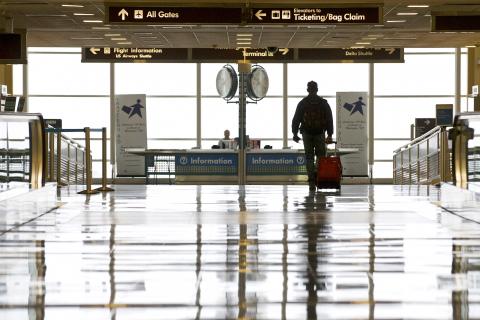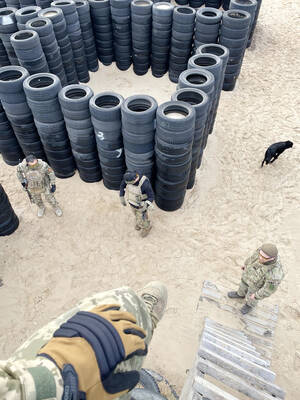It wasn’t long ago that the main selling point of a piece of luggage was its durability — think American Tourister and its rather excitable gorilla.
Not for Kevin Harwood.
Like many travelers today, he is looking for technology to go along with durability. He stumbled across a carry-on bag controlled by smartphone — with a Bluetooth-enabled lock, GPS tracking and a USB port for recharging a device. It has a built-in scale, too.

Photo: EPA
“I’m a little bit of a geek, always looking for products that extend from my phone, that connect my world and me,” said Harwood, a 30-year-old software developer from Austin, Texas.
Why should luggage be any different?
At the crowdfunding site Indiegogo he was among the first to buy into a startup called Bluesmart that is developing a connected bag. Harwood has plenty of company. Bluesmart raised more than US$2 million from more than 10,000 backers, far surpassing its goal.
Bluesmart, which expects to deliver its first bags in October, is part of what has become a stampede of businesses — both startup and established — into the nascent connected luggage industry.
Samsonite just introduced a new line of GeoTrakR suitcases, containing a cellular-enabled baggage-tracking system from LugLoc, at the Travel Goods Association trade show in Las Vegas. Andiamo will introduce a new carry-on with a Wi-Fi hotspot, battery charger and other features.
Delsey has been soliciting feedback since late last year for its Pluggage line of smart suitcases.
Even telecom companies are interested. AT&T is researching development of a smart bag, described in a YouTube video posted last summer, that tracks a bag from airport to airport. Rimowa, a German luggage manufacturer, is jointly developing a smart suitcase line called Bag2Go with Airbus and Deutsche Telekom. The new bags, expected to be available next year, will interact with sensors in the cargo holds of Airbus aircraft to identify their location.
“Adding electronic capability and communications to baggage makes a lot of sense,” said Frank Gillett, an analyst at Forrester Research. “What you’re seeing is the first round of innovation that will take time to evolve. The goal is to improve the travel experience.”
Hanif Perry, a 32-year-old New York-based marketing consultant who also participated in Bluesmart’s Indiegogo campaign, said he liked its bag’s laptop pocket. The carry-on, he said, “is more purposefully designed for the younger traveler who carries all devices.”
Bluesmart is not the only luggage venture raising money through crowdfunding. Trunkster collected US$1.4 million from 3,500 investors through Kickstarter, easily surpassing its goal. Jesse Potash, a co-founder, said it would release a carry-on and a suitcase in late summer.
Trunkster’s bags will have a tracking system, a scale and a battery with two USB chargers, Potash said, as well as a roll-top entry providing quick access.
The push for the connected bag solves one of the most vexing problems for travelers — lost luggage.
“The last thing that you want to have happen is an unwelcome surprise of a suitcase disappearing,” said Henry Harteveldt, travel analyst for Atmosphere Research Group. “This is peace-of-mind technology.”
Travelers who want to track their bags but not replace luggage they already own, or who are concerned about a suitcase’s embedded tracking system possibly malfunctioning, have another option: free-standing devices.
Beside LugLoc — which uses Bluetooth and GSM technology and costs $70, plus additional search fees — there is Trakdot, whose GSM device texts and emails users the location of their checked suitcase when their plane lands and costs $50, plus an annual service fee of $20.
Franck Dubarry, founder of Lev Technology, said his company would introduce a Smart Unit device this summer that will tell users where their bags are after flights. It will cost $99, plus activation and other fees.
To comply with regulations governing personal electronic devices, the tracking systems are generally designed to automatically shut down once they are stored and to automatically turn back on once a plane lands.
Experts say this new smart baggage represents just the first wave of this equipment.
“Products that make travel easier and better for customers quickly spread throughout the market,” said Michele Marini Pittenger, president of the Travel Goods Association. “To use recent examples, we’ve seen lightweight bags, expandable cases and four-wheeled luggage rapidly become the new normal,” she said.
And what about that American Tourister commercial with the gorilla (actually, a man in a gorilla suit)? Those commercials lasted 15 years, ending in 1985 — quite durable, as ad campaigns go.

May 18 to May 24 Pastor Yang Hsu’s (楊煦) congregation was shocked upon seeing the land he chose to build his orphanage. It was surrounded by mountains on three sides, and the only way to access it was to cross a river by foot. The soil was poor due to runoff, and large rocks strewn across the plot prevented much from growing. In addition, there was no running water or electricity. But it was all Yang could afford. He and his Indigenous Atayal wife Lin Feng-ying (林鳳英) had already been caring for 24 orphans in their home, and they were in

On May 2, Chinese Nationalist Party (KMT) Chairman Eric Chu (朱立倫), at a meeting in support of Taipei city councilors at party headquarters, compared President William Lai (賴清德) to Hitler. Chu claimed that unlike any other democracy worldwide in history, no other leader was rooting out opposing parties like Lai and the Democratic Progressive Party (DPP). That his statements are wildly inaccurate was not the point. It was a rallying cry, not a history lesson. This was intentional to provoke the international diplomatic community into a response, which was promptly provided. Both the German and Israeli offices issued statements on Facebook

Even by the standards of Ukraine’s International Legion, which comprises volunteers from over 55 countries, Han has an unusual backstory. Born in Taichung, he grew up in Costa Rica — then one of Taiwan’s diplomatic allies — where a relative worked for the embassy. After attending an American international high school in San Jose, Costa Rica’s capital, Han — who prefers to use only his given name for OPSEC (operations security) reasons — moved to the US in his teens. He attended Penn State University before returning to Taiwan to work in the semiconductor industry in Kaohsiung, where he

Australia’s ABC last week published a piece on the recall campaign. The article emphasized the divisions in Taiwanese society and blamed the recall for worsening them. It quotes a supporter of the Taiwan People’s Party (TPP) as saying “I’m 43 years old, born and raised here, and I’ve never seen the country this divided in my entire life.” Apparently, as an adult, she slept through the post-election violence in 2000 and 2004 by the Chinese Nationalist Party (KMT), the veiled coup threats by the military when Chen Shui-bian (陳水扁) became president, the 2006 Red Shirt protests against him ginned up by